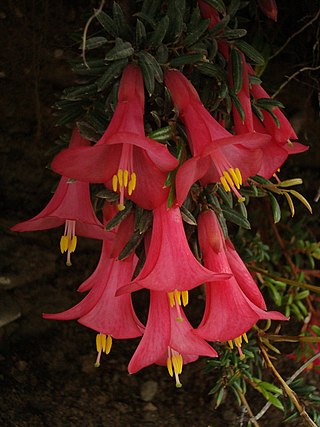
Poa flabellata, commonly known as tussac grass or just tussac, is a tussock grass native to southern South America, the Falkland Islands, South Georgia and other islands in the South Atlantic. There are also two isolated records from the herbarium at the French Muséum national d'histoire naturelle for the Île Amsterdam in the Indian Ocean.

Berberis microphylla, common name box-leaved barberry and Magellan barberry, in Spanish calafate and michay and other names, is an evergreen shrub, with simple, shiny box-like leaves. The calafate is native to southern Argentina and Chile and is a symbol of Patagonia. Berberis microphylla should not be confused with Mahonia microphylla, native to China.

Brachionidium is a genus of about 72 species of orchids, found throughout much of tropical America . The generic name comes from Greek and refers to the protrusions on the stigma.

Philesia is a South American genus of flowering plants in the family Philesiaceae first described as a genus in 1789.

Rostkovia is a genus of flowering plants in the family Juncaceae. It was described in 1809.

Karl Friedrich Reiche was a German botanist who worked as a university professor in Chile and Mexico.

Bidens laevis is a species of flowering plant in the daisy family known by the common names larger bur-marigold and smooth beggarticks. It is native to South America, Mexico, and the southern and eastern United States. It grows in wetlands, including estuaries and riverbanks.
Oplismenopsis is a genus of South American plants in the grass family. The only known species is Oplismenopsis najada, native to southern Brazil, Uruguay, and northeastern Argentina.
Neobouteloua is a genus of Argentine and Chilean plants in the grass family.

Aechmea mariae-reginae is a species in the genus Aechmea. endemic to Central America. This is one of the few Bromelioideae species that is dioecious, and is the only species in its genus with this trait.

Veronica elliptica, synonym Hebe elliptica, is a plant of the family Plantaginaceae. It is native to New Zealand, south Argentina, south Chile and the Falkland Islands. It is an evergreen, bushy shrub of 1 m or more in height, with green, oval leaves, 2–4 cm long. Flowers are white to pale mauve.

Hippeastrum aulicum, the Lily of the Palace, is a bulbous perennial, in the family Amaryllidaceae, native to the Atlantic Forest and Cerrado ecoregions from Brazil to Paraguay, in South America.

Hippeastrum cybister is a flowering perennial herbaceous bulbous plant, in the family Amaryllidaceae, native from Bolivia to Argentina.

Hippeastrum papilio is a flowering perennial herbaceous bulbous plant, in the family Amaryllidaceae, native to southern Brazil.

Hippeastrum psittacinum is a flowering perennial herbaceous bulbous plant, in the family Amaryllidaceae, native to Brazil.

Heterostachys is a genus of flowering plants in the plant family Amaranthaceae. The two species are shrubby halophytes native to South America and Central America.

Philodendron appendiculatum, also known as güembé, is a perennial species in the genus Philodendron, belonging to the family Araceae. It lives in the jungles, wetlands, and moist forests of South America.

Allenrolfea is a genus of shrubs in the family Amaranthaceae. The genus was named for the English botanist Robert Allen Rolfe. There are three species, ranging from North America to South America.

Dr. Charlotte M. Taylor is a botanist and professor specialising in taxonomy and conservation. She works with the large plant family Rubiaceae, particularly found in the American tropics and in the tribes Palicoureeae and Psychotrieae. This plant family is an economically important group, as it includes plant species used to make coffee and quinine. Taylor also conducts work related to the floristics of Rubiaceae and morphological radiations of the group. Taylor has collected plant samples from many countries across the globe, including Chile, Colombia, Costa Rica, Panama, and the United States of America, and has named many new species known to science from these regions. As of 2023, Taylor has authored 500 land plant species' names, the third-highest number of such names authored by any female scientist.

Quito Botanical Garden is a park, botanical garden, arboretum and greenhouse of 18,600 square meters in the city of Quito, Ecuador. It houses species of plants of the country.


















